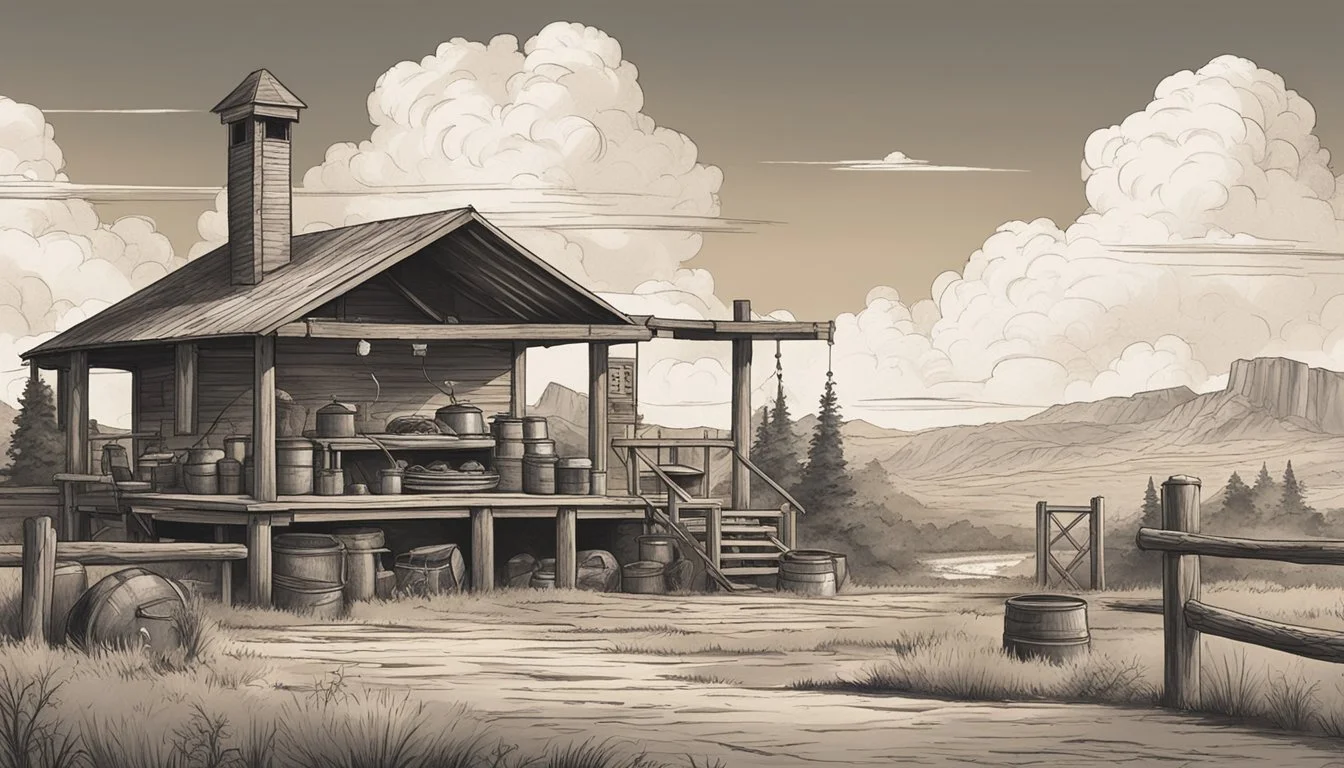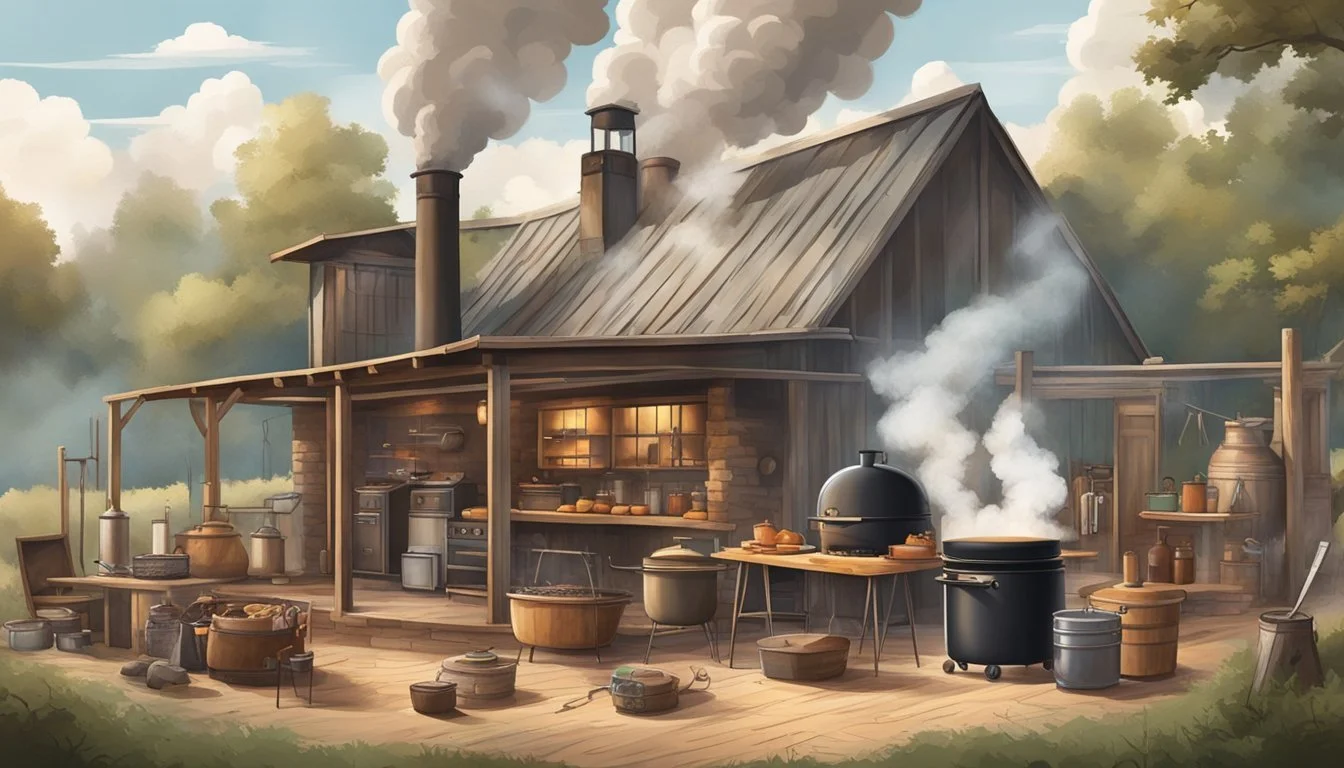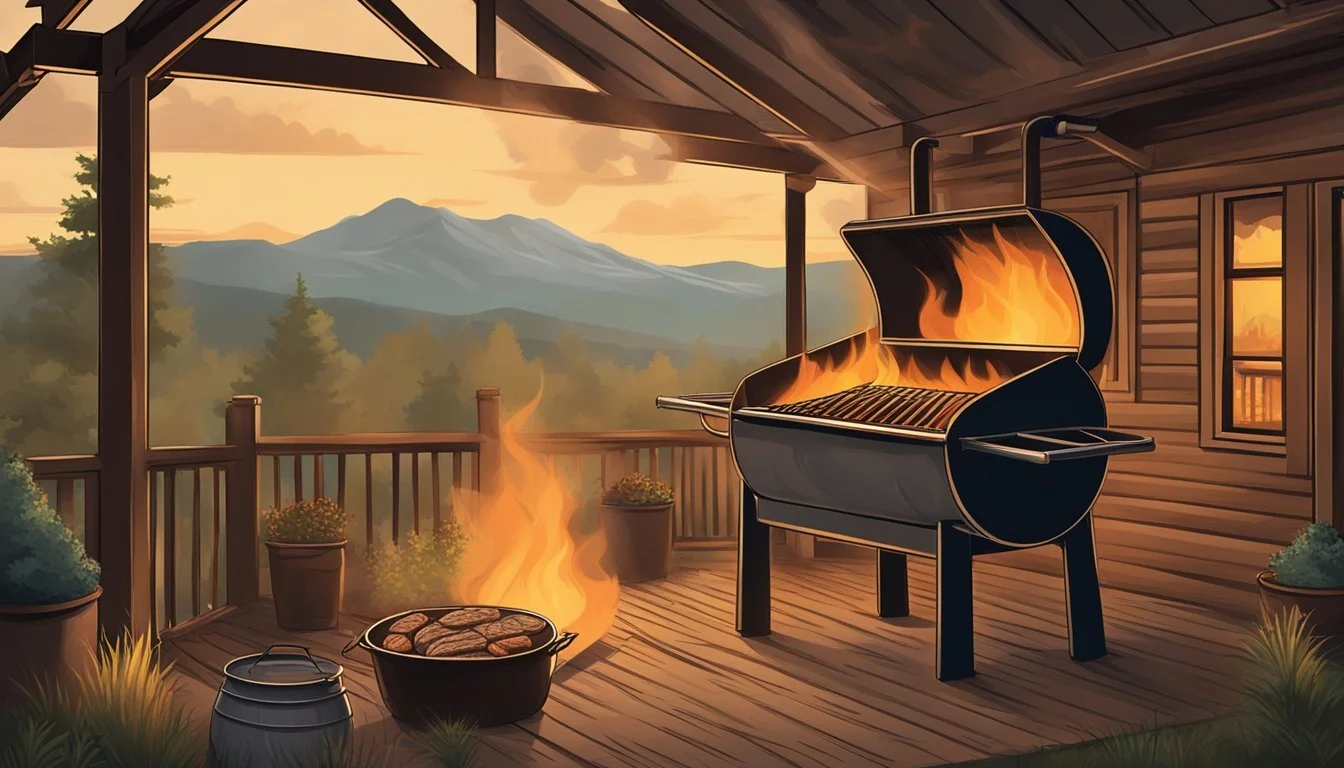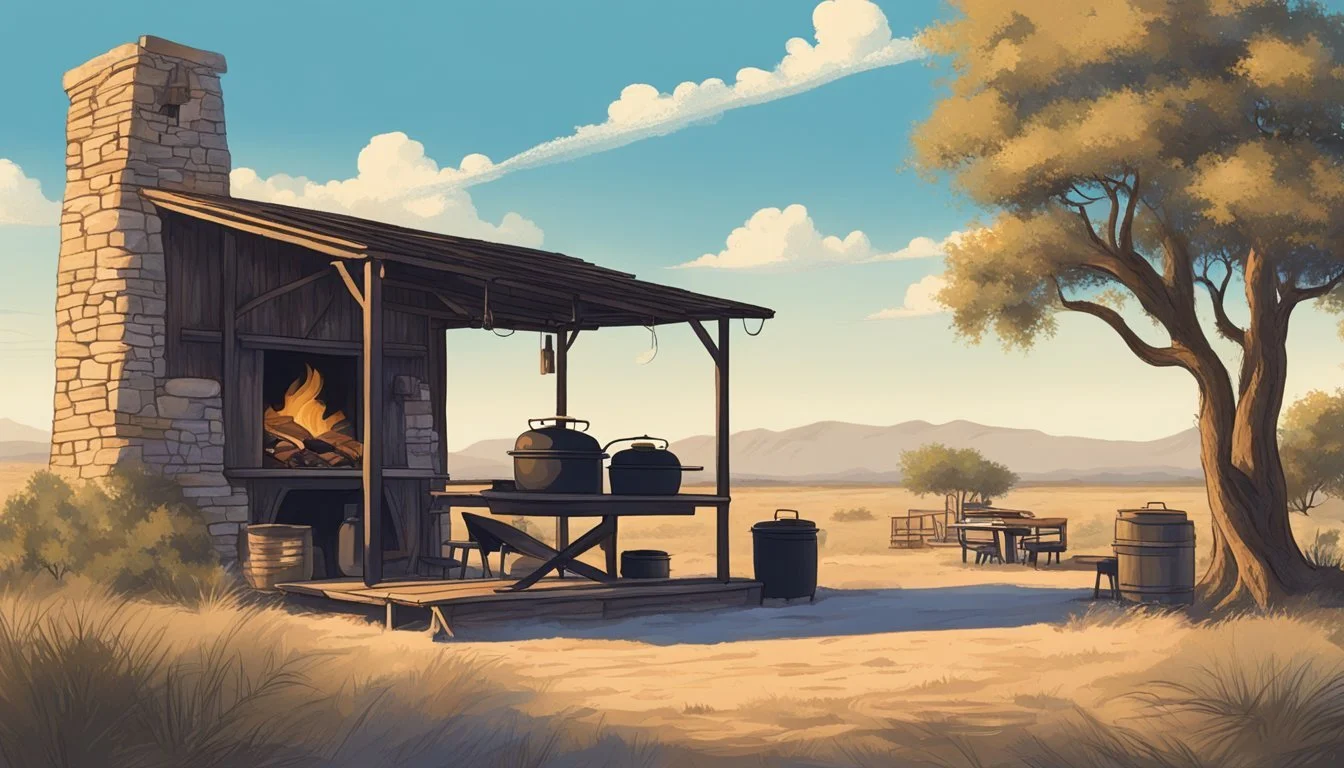The Art of Barbecue
Smoking Techniques from the Texas Range - Mastering Authentic Flavors
Venturing into the heartland of Texas barbecue is an exploration of a robust culinary tradition deeply woven into the fabric of the Lone Star State. Here, the art of barbecue (What wine goes well with barbecue?) is a testament to a history of regional flavor and communal gatherings. More than a mere method of cooking, Texas barbecue represents a gastronomic narrative that has evolved over time, yet steadfastly honors its roots. This culinary tradition isn't simply about the food; it's about the meticulous process and the cultural identity that emerges within the smoke that billows from the pits of Texas.
The practice of smoking meat in Texas is a craft that revolves around patience, precision, and understanding the subtleties of flavor and texture. Central to this craft is the 'Texas Trinity' of brisket, ribs, and sausage, each requiring a finesse in smoking techniques to achieve the characteristic tenderness and flavor. The choice of meat is crucial, typically drawing upon local sources to ensure freshness and quality. A distinctive feature of this style of cooking lies in wood selection, with oak and pecan being popular choices for infusing meat with a rich, aromatic smoke that complements the natural flavors.
Barbecue culture in Texas is not just about what's on the plate; it's also about the experience it brings forth. Cooking over a low, slow heat, pitmasters and amateurs alike partake in a time-honored ritual, a slow dance that can last several hours, or even a full day, depending on the cut and size of the meat. The result is more than a meal; it's the centerpiece of community, conversation, and pride in a tradition that has been savored for generations.
History and Traditions of Texas BBQ
Texas BBQ reflects a rich mosaic of history and culture, marking its significance not just as a culinary practice but as a vital part of the Lone Star State's identity. This section delves into the historical roots, cultural influence, and the evolution of the diverse regional styles that make Texas BBQ a subject of both pride and tradition.
Roots in Culinary Tradition
The inception of Texas BBQ can be traced back to the cattle drives in the 1800s, where the tradition of slow-cooking tough cuts of meat was born out of necessity. This method, perfected over generations, encapsulated the essence of Texas BBQ, with its focus on beef as the primary protein. The influence of Mexican cooking techniques was significant, introducing spices and methods that have become synonymous with Texas BBQ.
Influence on Texas Culture
Barbecue in Texas is more than a way of cooking; it's a cultural phenomenon, deeply entrenched in the social fabric of the state. It acts as a common thread that brings communities together, with family-owned barbecue joints being a testament to its stature. These establishments often serve as cultural landmarks, passing from one generation to another and maintaining the legacy of traditional Texas BBQ.
Evolution of Regional Styles
Diverse regional styles within Texas reflect the state's size and cultural variety. Central Texas barbecue, renowned for its emphasis on smoking meats to perfection, opts for simplicity in its rubs, letting the meat's natural flavors shine. In contrast, East Texas barbecue is characterized by its fall-off-the-bone, marinated meats, often chopped and served in sandwiches. South Texas barbecue is heavily influenced by Mexican flavors, where barbacoa—a style of cooking meat in a pit covered with agave leaves—is a popular tradition. Each region's unique approach showcases the adaptability and innovation that have defined Texas BBQ for centuries.
Essential Equipment
The mastery of Texas barbecue hinges on the selection and understanding of equipment and materials. One's choice of smoker and wood significantly influences the flavor and quality of the barbecue.
Selecting the Right Smoker
The smoker is the cornerstone of barbecue equipment, serving as the apparatus that maintains a controlled, consistent environment for slow-cooking meats. Key considerations when choosing a smoker include size, material, and fuel type. Enthusiasts often select from offset smokers, which are renowned for their traditional design and indirect heating capability, or more modern pellet smokers, which utilize wood pellets for fuel and offer precise temperature control.
Type of Smoker Description Offset Smoker Ideal for large cuts; fueled by charcoal or wood Pellet Smoker Automated temperature control; uses compressed wood pellets Electric Smoker Convenient plug-and-play; lacks traditional smoky flavor Kamado Grill Ceramic construction; versatile for grilling and smoking
Types of Barbecue Pits
A barbecue pit refers to a contained space where meat is cooked over a direct or indirect flame. The traditional Texas pit is often constructed from steel or brick, embodying a larger, stationary fixture. Meanwhile, portable pits cater to enthusiasts who prefer mobility without compromising the capacity for creating authentic smoky flavors. Each style of pit can contribute its own character to the barbecue experience.
Understanding Wood and Smoke
The choice of wood plays a pivotal role in imparting aroma and depth to the smoked meat. Harsher woods like mesquite produce a strong flavor suitable for short smoking periods. Milder woods such as oak and pecan offer a balanced taste recommended for longer sessions. Among the favorites in Texas is post oak, a wood that imparts a subtle, smoky aroma preferred by pitmasters for its consistency and traditional profile.
Wood Type Flavor Profile Best Used For Mesquite Robust, earthy Quick smokes; strong-flavored meats Oak Medium smoke Versatile; good for most meats Pecan Sweet, nutty Delicate meats; nuanced smoky flavor Hickory Bold, bacon-like Pork and ribs; hearty smoky taste Post Oak Mild, smoky Beef brisket; (What wine goes well with beef brisket?) traditional Texas BBQ
Through careful selection of a smoker, understanding of barbecue pit types, and consideration of wood choices, one can create the quintessential Texas barbecue with a rich and distinctive smoky flavor.
The Art of Smoking
Smoking meat is both a science and an art, capturing the essence of flavor through carefully chosen techniques and methods. This section encapsulates the process from selecting the right cut to achieving the coveted smoke ring.
Choosing Your Cut
The selection of meat is crucial in smoking. Opt for cuts with ample marbling and connective tissues that transform into gelatin under prolonged heat, lending tenderness and flavor. Beef brisket, ribs, and pork shoulder are top choices for their texture and fat content.
Brisket: The Icon of Texas BBQ
Brisket stands as the touchstone of Texas barbecue, a cut from the lower chest of beef. It consists of two parts, the flat and the point, each offering varying degrees of marbling and flavor. The brisket's dense structure demands a meticulous smoking approach to break down its tough fibers.
Preparation and Seasoning
Preparation begins with trimming the brisket to ensure even cooking. A simple rub of salt and pepper, known as a dalmatian rub, often suffices to enhance its natural flavors without overpowering the meat. Some pitmasters may include garlic powder or paprika in their rub for an added dimension.
Smoking Low and Slow
The magic of the barbecue emerges from the low and slow technique—cooking at a low temperature for several hours. This allows heat to gently penetrate the meat, progressively softening the connective tissues and saturating the muscle fibers with smoky aromas.
Managing Temperature and Smoke
Controlling the smoker's temperature is critical, usually between 225°F to 250°F. Consistency is key to preventing the meat from drying out. For smoke production, hardwoods like oak, hickory, or mesquite are favored for their ability to impart a rich flavor profile fitting for the region's style.
Achieving the Perfect Smoke Ring
The smoke ring, a pinkish layer beneath the surface, indicates a successful smoke penetration. It's not a measure of flavor but a visual cue formed by the reaction of nitric oxide from the smoke with the meat's myoglobin. Wrapping brisket in butcher paper can trap moisture and heat without suffocating the cut, aiding in the formation of this coveted feature.
Flavor Profiles and Seasoning
In Texas barbecue, the mastery of flavor profiles and seasoning is paramount. Precision in this craft ensures that the meat's natural flavors are not only preserved but elevated.
The Simplicity of Salt and Pepper
Texas barbecue often begins with the foundational seasonings of salt and black pepper. This simple combination, referred to sometimes as the "Dalmatian rub," provides a robust and unobtrusive flavor base that complements the smokiness of the meat without overpowering it.
Unique Regional Seasonings
While the basics are revered, creative pitmasters integrate unique regional seasonings to distinguish their barbecue. For example, further west, a touch of cumin might be common, while along the coast, one could encounter a hint of cayenne pepper for a subtle spicy kick.
Dry Rubs vs. Marinades
Dry Rubs: A classic Texan approach involves applying a dry rub—a mixture of dry spices and herbs—onto the meat before smoking. Dry rubs create a crusty, flavorful exterior, often seen on brisket and ribs.
Ingredients for a Typical Dry Rub Usage Paprika (for smokiness and color) Generously applied Cayenne Pepper (for heat) Sparingly sprinkled
Marinades: Alternatively, marinades use a liquid base to infuse the meat with flavor. Texan marinades may incorporate bold ingredients like vinegar or beer, offering a different but equally flavorful experience.
Meats and Alternatives
When it comes to Texas BBQ, the focus is on selecting the best cuts and employing precise smoking techniques to achieve tender, flavorsome results.
Exploring Beef and Brisket
In Texas, beef, specifically beef brisket, is king. Pitmasters choose high-quality beef with good marbling to ensure that the meat remains tender throughout the long smoking process. A typical tender brisket is prepared by smoking it low and slow, which can take up to 12-20 hours depending on the size and thickness of the cut. Cow meat, particularly beef brisket, is revered for its rich flavor and tenderness when prepared correctly.
Pork, Ribs, and Sausage
Pork ribs (What wine goes well with pork ribs?) are another staple of Texas BBQ. They are known for their succulent meat which, when smoked properly, can easily pull away from the bone. Sausage, typically made from ground pork, is a versatile option that's smoked to enhance its spiciness and natural flavors. Here's a quick look at these options:
Pork Ribs: Seasoned with a simple rub and smoked over oak or hickory until tender.
Sausage: Handcrafted links, often a mix of beef and pork, smoked to achieve a firm yet juicy texture.
Chicken and Other Proteins
While chicken may not be as central as beef or pork in Texas BBQ, it is nonetheless a popular choice for its quick cooking time and ability to absorb smoky flavors. Beyond chicken, one can occasionally find alternatives like goat, smoked to bring out its unique taste while ensuring the meat remains tender. Here’s a brief overview:
Chicken: Often brined and smoked until the skin is crispy and the meat is juicy.
Goat: A less common but traditional option, usually reserved for special occasions and smoked similar to lamb.
Cooking Practices
In the realm of Texas barbecue, the line between science and tradition blurs, uniting into a symphony of slow-cooked delights. Cooking practices are meticulously honed to ensure the meat is succulent, infused with flavor, and tender enough to melt in your mouth.
Direct vs. Indirect Heat
Direct heat involves placing meat directly over the fire, cooking it quickly at higher temperatures. This method sears the meat, producing a flavorful crust. Indirect heat, on the other hand, refers to cooking the meat away from the flames, often in a covered grill or smoker. This method is synonymous with the prized "low and slow" technique, essential for rendering tough cuts into tender meat—with slow smoking it slowly breaks down connective tissues without overcooking.
The Role of Moisture
Maintaining moisture is pivotal for achieving juicy, tender barbecue. Several strategies ensure this:
Marinating: Infusing the meat with moisture-rich marinades can add flavor and tenderness.
Mopping/Spritzing: Regularly applying a mop sauce or spritz keeps the surface from drying out during long cooking periods.
Water Pans: Placing water pans within the cooking chamber can help regulate temperature and maintain a humid environment to prevent dehydration.
Resting and Serving
After slow-cooking, meat must rest, typically for a period ranging from 15 minutes to an hour, depending on the size of the cut. This waiting period allows juices redistributed throughout the meat, ensuring that each bite is as flavorful and moist as the last. When it comes to serving, slicing against the grain ensures the meat is at its most tender, offering an effortless chew and allowing the complex flavors developed during the cook to shine.
Complementary Dishes and Sides
In the realm of Texas barbecue, the meats might be the stars, but the supporting cast of sides is what completes the meal, offering a contrast in flavors and textures to enhance the overall experience.
Traditional Texas Sides
Beans: Pinto beans slow-cooked with a blend of spices and brisket trimmings are a staple Texas barbecue side dish. Baked beans often feature a tangy sauce with a hint of sweetness. Coleslaw: A creamy slaw, typically mayo-based, brings a refreshing crispness to the table, balancing the richness of smoked meats. Potato Salad: Another classic, this dish is usually made with a mayonnaise dressing and occasionally mustard, combining soft potatoes with a creamy texture.
Breads and Carbohydrates
Cornbread: A sweet and savory Southern favorite, cornbread offers a crumbly texture and a hint of sweetness. White Bread: Simple slices of white bread are traditional for sopping up meat juices and sauce, providing a soft and absorbent addition.
Vegetables and Salads
Onions: Pickled or fresh, onions lend a sharp bite that contrasts with the deep, smoky flavors of the barbecue. Salads: Beyond coleslaw, other fresh salads featuring greens, tomatoes, and a light dressing provide a palate-cleansing element to the hearty meat-centric meal.
Each dish complements the smoky and savory flavors of barbecue, from South Texas barbacoa to slow-smoked brisket, rounding out the dining experience with a symphony of taste and texture.
Pitmaster Techniques and Profiles
In Texas BBQ, the expertise of pitmasters is paramount, with years of experience shaping a robust culinary tradition. Techniques vary, but the essence of their craft remains a pursuit of perfection in smoked meat.
Famous Texas Pitmasters
Tootsie Tomanetz: With decades of BBQ mastery, Tomanetz's traditional techniques at Snow's BBQ have earned the eatery the title of best barbecue in Texas by "Texas Monthly" in 2008.
Aaron Franklin: A contemporary icon of Texas BBQ, Franklin has achieved national recognition for his establishment, Franklin Barbecue, through a meticulous approach to smoking meat that emphasizes consistency and quality.
Pitmaster Secrets and Tips
Selecting the Meat: Pitmasters emphasize the importance of starting with high-quality meat—typically a well-marbled cut—as the foundation for exceptional BBQ.
Maintaining the Fire: Consistent temperature control is crucial, with a preference for maintaining a low and slow fire to achieve perfectly cooked meats.
Wood Choices: Pitmasters often use oak or hickory, which impart a robust flavor to the meat.
Patience Is Key: The common adage among pitmasters is that good BBQ can't be rushed. It's the slow smoking process that tenderizes the meat and enriches it with flavor.
Servicing and Celebrating BBQ
Barbecue in Texas is more than just a method of cooking—it's a cultural experience deeply ingrained in the Lone Star State, passed down through generations. The community gathers around this smoky cuisine, celebrating their heritage and shared love for slow-cooked meats.
Hosting Barbecue Gathers
Texans often host barbecue gatherings to celebrate special occasions or simply to enjoy good company. A barbecue host must consider not only the quality and variety of meats but also the cooking time and resources:
Preparation: Meats are typically marinated with a blend of spices before smoking.
Smoking: Meats such as brisket are smoked "low and slow", often for 10 to 12 hours.
Serving: Barbecue is typically served with sides like coleslaw, beans, and cornbread.
At these gatherings, the aroma of smoked meat is an invitation to connect, creating a welcoming atmosphere where stories are shared and friendships are nurtured.
Texas Barbecue Competitions
Competitions are a public showcase of skill and a testament to the meticulous art of Texas barbecue. Here, pitmasters from across the state come together to demonstrate their expertise and vie for the title of the best barbecue:
Judging Criteria: Flavor, tenderness, and presentation are key factors.
Community Involvement: Competitions are often community events, with proceeds going to local charities.
Barbecue competitions are about more than just winning; they're a celebration of tradition, a testament to the pitmasters' years of refining their methods, and an opportunity for the community to bond over a shared passion.
Safety and Maintenance
Ensuring the safe operation and longevity of barbecue equipment is paramount. Proper techniques and regular upkeep can prevent accidents and extend the life of the smoker.
Preventing Flare-Ups
To mitigate the risk of dangerous flare-ups:
Maintain a clean grill: Build-up of grease and fat can ignite when heated.
Trim excess fat from meats before smoking to reduce the amount of fat that can drip and cause a flare-up.
Monitor temperature closely and use a drip pan to catch fats and juices.
Regular Cleaning Routines
Effective cleaning routines include:
After each use: Brush the grates to remove debris and wipe down surfaces.
Monthly deep clean: Disassemble parts as appropriate to clean interior surfaces and grates with a dedicated grill cleaner.
Check for residue: Occasionally inspect for grease accumulation in trays and dispose of it properly.
Long-Term Equipment Care
For equipment longevity:
Rust prevention: Store equipment in a dry place and cover when not in use to protect from the elements.
Replace parts: Regularly check for wear and tear, replacing any faulty components like seals or thermometers.
Season your smoker: Apply a high-temperature cooking oil to the inside surface and heat to form a protective layer.
Future of Texas Barbecue
The Texas barbecue landscape is continuously evolving with new smoking techniques and sustainable practices. At the same time, the wisdom gleaned from generations’ worth of experience anchors the tradition in its roots.
Innovations in Techniques
In the world of Texas barbecue, innovation is synonymous with refining the art of slow smoking. Pitmasters are embracing cutting-edge technologies, such as precise temperature controls and automated smoke-flow systems, to enhance the consistency and flavor of their barbecue. Precision cooking appliances are becoming more common, allowing for a level of control over the smoking process that was previously difficult to achieve.
Sustainability and BBQ
Sustainability has become integral to the future of Texas barbecue. Restaurants and pitmasters are sourcing meats and woods responsibly, aiming to reduce their carbon footprint. Using local, ethically raised meats and native, renewable wood species are steps being taken to ensure Texas barbecue can be enjoyed by future generations without compromising the state's ecological integrity.
Intergenerational Knowledge
The transmission of barbecue knowledge from one generation to the next remains the pillar of Texas barbecue culture. With each transfer, there's an addition of modern insights that keeps the culinary tradition fresh and exciting. The experience of long-standing pitmasters intertwines with the creative flair of the younger generation, ensuring that tradition and innovation balance each other out. Formal and informal educational efforts, such as culinary schools and family mentoring, sustain the longevity and relevance of Texas barbecue.







